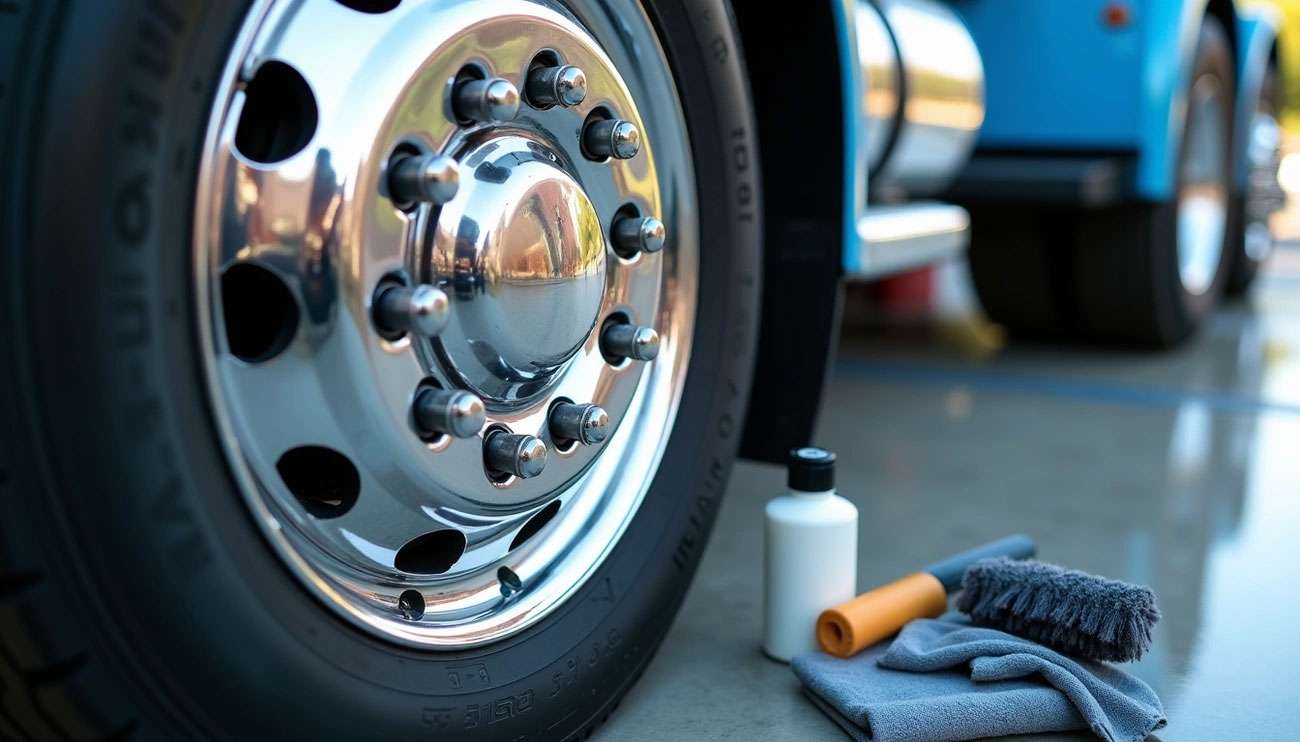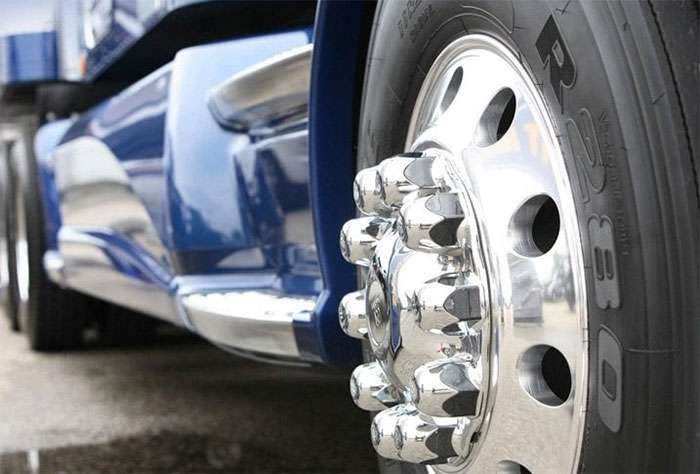
Polished aluminum wheels demand specialized care to maintain their mirror-like finish and structural integrity. These precision-engineered components feature porous surfaces that trap contaminants, making proper maintenance essential for protecting your investment from permanent damage.
Brake dust creates the biggest challenge for aluminum rim maintenance. This abrasive buildup forms when brake pads contact rotors during stopping, creating particles that bond to wheel surfaces. Wrong cleaning methods or harsh chemicals can cause irreversible damage to these expensive components, leading to costly replacements. Salt from winter roads presents another serious threat, corroding metal surfaces and creating pitted areas that worsen without prompt attention.
Maintaining polished truck rims requires commitment and proven strategies, whether you face harsh weather conditions or daily road grime. Regular maintenance delivers impressive results. Weekly rinses combined with monthly deep cleaning prevent oxidation, pitting, and structural damage while preserving that professional appearance. Well-maintained wheels boost your truck's resale value and create a strong professional impression that sets you apart.
This guide provides professional-grade techniques that protect your wheel investment and keep your truck rims looking their absolute best for years to come.

Image Source: TRUCKiD
Understanding your truck rim materials and finishes forms the foundation of effective maintenance. Different materials require specific care approaches, and the wrong technique can damage expensive wheels. Before starting any maintenance routine, identify exactly what type of rims you're working with.
Steel rims deliver exceptional durability for heavy-duty applications and worksite conditions. These welded components weigh approximately 2.5-3 times more than equivalent aluminum wheels of the same size. Steel provides superior impact resistance and better winter traction, making it ideal for commercial trucks. However, steel requires protective coatings to prevent rust and corrosion from developing.
Aluminum alloy rims combine aluminum with other metals like nickel or magnesium to create lightweight wheels that improve fuel efficiency and handling performance. The malleable nature of aluminum allows for diverse design options compared to steel. Aluminum naturally forms a microscopic oxide layer just 0.0002 cm thick that provides built-in corrosion resistance.
Chrome represents a finish rather than a base material. This multi-layer coating gets applied over steel or aluminum wheels to create the mirror-reflective appearance many truck owners prefer.
The magnet test provides the quickest identification method. Magnets stick to steel wheels but won't attach to aluminum or magnesium rims. When polishing bare aluminum, you'll see black residue accumulating on your cloth—this indicates oxidized aluminum particles. Polished aluminum displays brighter, more reflective surfaces with vibrant silver coloring compared to other finishes.
Special finish labels offer additional identification clues. Alcoa's Dura-Bright wheels come with different colored labels—blue labels indicate wheels needing frequent maintenance, while black labels show better corrosion resistance.
Each wheel finish demands specific maintenance techniques. Chrome-plated wheels need gentle cleaning with mild soap and soft materials—abrasive products scratch the reflective coating. Bare aluminum without protective coating requires frequent polishing and waxing to prevent oxidation and surface pitting.
Clear-coated wheels present special challenges. Never use acidic cleaners or metal polish on these wheels, as these products damage the protective clear coat layer. Powder-coated finishes offer superior resistance to rust, heat, and scratches but cannot be easily refinished if damaged.
Knowing your specific rim type determines which cleaning products work safely, how often maintenance is needed, and what protective steps extend wheel life. This knowledge prevents costly mistakes that could permanently damage your investment.

Image Source: Image Wash Products
Proper rim cleaning goes beyond appearance—it's essential preventative maintenance that removes corrosive brake dust before it causes permanent damage to your expensive wheels. Professional cleaning techniques make the difference between rims that last decades and those requiring costly replacement.
Always start with completely cool wheels. Hot surfaces cause cleaners to evaporate too quickly, leaving residues that can damage your finish. Before applying any products, inspect each rim for cracks, bends, or welding repairs that could compromise safety. Check lug nuts for security during your inspection—shiny streaks or rust trails indicate dangerous loosening that needs immediate attention.
Quality tools make cleaning safer and more effective. Your essential toolkit includes:
pH-balanced wheel cleaner designed specifically for your rim type
Soft-bristle brushes in multiple sizes for different areas (wheel face, barrel, lug nuts)
Microfiber towels for streak-free drying
Clean water bucket
Wheel sealant or protectant for ongoing protection
For polished aluminum, choose cleaners explicitly labeled for aluminum that dissolve brake dust without attacking the metal surface.
Follow this proven sequence for best results:
Rinse thoroughly from top to bottom, removing loose debris
Apply wheel cleaner generously to all surfaces and crevices
Let the cleaner work for 60-90 seconds—never allow it to dry completely
Scrub systematically using appropriate brushes for each area
Rinse immediately and thoroughly after scrubbing
Dry completely with clean microfiber towels to prevent water spots
While brake dust forms naturally, smart preventative measures reduce buildup significantly. Wheel-specific sealants create protective barriers that make future cleaning easier. Consider upgrading to ceramic brake pads, which produce much less visible dust than standard metallic pads. For maximum protection, ceramic coatings provide semi-permanent barriers against contaminants.
Consistency matters most—weekly rinses prevent brake dust from bonding permanently to your aluminum surfaces.

Image Source: YouTube
Proper polishing creates that mirror finish while providing essential protection against oxidation and contamination. The right polishing schedule extends wheel life significantly.
Commercial trucks need basic polishing every 2-3 months under normal operating conditions. When rims show dullness, oxidation, or water spotting, immediate attention prevents permanent damage. Always start with completely cool wheels and wear appropriate safety gear including respiratory protection—aluminum dust poses serious health risks.
Hand polishing provides superior control for detailed work and eliminates the risk of wheel damage from excessive speed. Machine polishing delivers consistent results across large surface areas but demands greater skill and experience. For deep scratches or heavy oxidation, machine polishing with a 3,500 RPM polisher produces the best results—never attempt 6,000 RPM settings without professional experience.
Quality sealants and ceramic coatings provide long-term protection after polishing. Ceramic coatings form a transparent barrier that repels water, dirt, and brake dust while enhancing the mirror finish. These professional-grade coatings last 2-5 years compared to traditional waxes that require monthly reapplication. Allow ceramic coatings to cure for one full week before washing to ensure proper bonding.
Polishing dirty wheels without thorough cleaning first
Applying excessive pressure that creates heat damage and swirl marks
Using ceramic coatings in direct sunlight or temperatures below 45°F
Skipping regular maintenance after the initial polishing treatment
Applying iron removers or degreasing cleaners on ceramic-coated surfaces

Image Source: fifteen52
Protecting your truck rim investment requires systematic care that goes beyond occasional cleaning and polishing. Establishing consistent routines maximizes both appearance and longevity while preventing costly repairs down the road.
Weekly maintenance keeps contaminants from building up. A simple water rinse removes surface dirt and loose brake dust before it bonds to the wheel surface. Monthly deep cleaning with pH-balanced wheel cleaners designed for your specific rim type removes stubborn deposits safely. Complete drying with microfiber towels prevents water spots that can permanently mark polished surfaces.
Quality wheel protectants applied every few weeks create a barrier similar to car wax. These products maintain shine while making brake dust easier to remove during future cleanings.
Winter conditions demand increased attention. Road salt that causes corrosion requires more frequent cleaning to prevent permanent pitting. Summer heat creates different challenges—apply stronger protective coatings to shield against baked-on contaminants from dust and high temperatures.
Rainy seasons bring water spotting issues that require more frequent washing. Fall preparation includes applying durable sealants before winter weather arrives.
Certain symptoms indicate immediate inspection requirements. Steering wheel vibrations or unusual pulling while driving often signal bent or damaged rims. Visible cracks, dents, or corrosion spots require prompt professional evaluation.
Uneven tire wear patterns or repeated low tire pressure may indicate rim problems. Unusual driving noises like thumping or rattling warrant immediate inspection.
Proper tire pressure protects both tires and rim integrity. Store seasonal wheels in cool, dry locations away from direct sunlight. Long-term storage requires thorough cleaning followed by placement in ventilated, opaque bags.
Ready to upgrade? Get your next set of truck rims from quality providers who understand proper maintenance requirements.
Proper truck rims maintenance creates lasting value that extends well beyond appearance. This guide has equipped you with professional techniques for material identification, effective cleaning methods, and protective coating applications. Truck rims endure constant assault from brake dust, road salt, and environmental contaminants that can permanently compromise these expensive components without proper care.
The maintenance approach outlined here delivers measurable results. Weekly rinses combined with monthly deep cleaning prevent oxidation and corrosion while maintaining that professional image that sets your truck apart. Understanding your specific rim material—aluminum, chrome, or steel—ensures you select the right products and techniques that enhance rather than damage your wheels.
Polishing creates essential protection for aluminum rims prone to natural oxidation. Ceramic coatings and quality sealants provide long-term barriers against contaminants, reducing future cleaning frequency while maintaining superior appearance.
Weather-adjusted maintenance schedules maximize rim longevity. Winter demands increased attention to combat corrosive road salt, while summer requires robust protective barriers against heat and baked-on contaminants. This systematic approach preserves both aesthetics and structural integrity.
Well-maintained truck rims deliver impressive returns through enhanced vehicle appearance and preserved resale value. The techniques mastered here create that mirror-like finish that commands attention and projects professionalism. Ready to upgrade your current setup? Performance Plus Tire offers quality truck rims backed by the maintenance expertise you've learned here.
Master these essential truck rim maintenance strategies to protect your investment and maintain that professional shine that enhances your vehicle's value and appearance.
• Know your rim material first - Steel, aluminum, and chrome each require specific cleaning products and techniques to prevent permanent damage
• Clean weekly, deep clean monthly - Regular rinses prevent brake dust buildup while monthly pH-balanced cleaners remove stubborn contaminants safely
• Polish every 2-3 months for protection - Polishing isn't just cosmetic—it creates essential barriers against oxidation and corrosion damage
• Apply ceramic coatings for long-term defense - These protective layers last 2-5 years and repel brake dust, making future cleaning easier
• Adjust maintenance for seasons - Increase winter cleaning frequency to combat road salt corrosion and apply stronger summer protection against heat
Consistent maintenance prevents costly rim replacement while preserving that mirror-like finish that projects professionalism on the road. The time invested in proper care pays dividends through extended wheel life and maintained resale value.
To maintain shiny truck rims, clean them regularly (every 1-2 weeks), use pH-balanced cleaners, dry thoroughly with a microfiber towel, and apply a protective coating like a ceramic sealant. This routine prevents buildup and protects the finish.
While WD-40 can clean alloy wheels due to its ability to penetrate and remove grime, it's not ideal for regular maintenance. For long-term care, use products specifically designed for wheel cleaning and protection to avoid potential damage to the finish.
Powder coating is considered one of the most durable finishes for truck rims. It provides excellent resistance to chemicals, chipping, scratching, and fading. Additionally, it offers superior protection against corrosion and outdoor elements.
For commercial trucks, it's recommended to perform basic polishing every 2-3 months. However, if you notice dullness, oxidation, or water spotting, it's time to polish regardless of the timeframe. Regular polishing helps maintain the shine and protects the rim surface.
Look out for vibrations in the steering wheel, unusual pulling while driving, visible cracks or dents, noticeable corrosion, uneven tire wear, or repeated low tire pressure. If you experience any of these issues, it's time to have your rims professionally inspected and serviced.